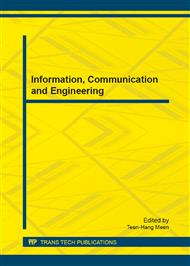p.93
p.99
p.105
p.111
p.117
p.123
p.129
p.135
p.141
Algorithm Design for Cluster Validity Based on Geometric Probability
Abstract:
Determining optimum cluster number is a key research topic included in cluster validity. Based on geometric probability, this article proposes a new cluster validity algorithm to determine optimum cluster number for two-dimension datasets. The algorithm measure the cluster structure of the data set according to the distributive feature of the point set in the characteristic space. The structure information of the point set has been stored in a line segment set generated by connecting each pair points in the point set and the cluster validity function is formed by comparing the values of line segment direction in the line segment set with those resulted from completely random condition. Experiments prove that the pattern of the function curve generated with a given example data set effectively enables determining the optimum cluster number of the data set.
Info:
Periodical:
Pages:
117-122
Citation:
Online since:
February 2013
Authors:
Price:
Сopyright:
© 2013 Trans Tech Publications Ltd. All Rights Reserved
Share:
Citation:


